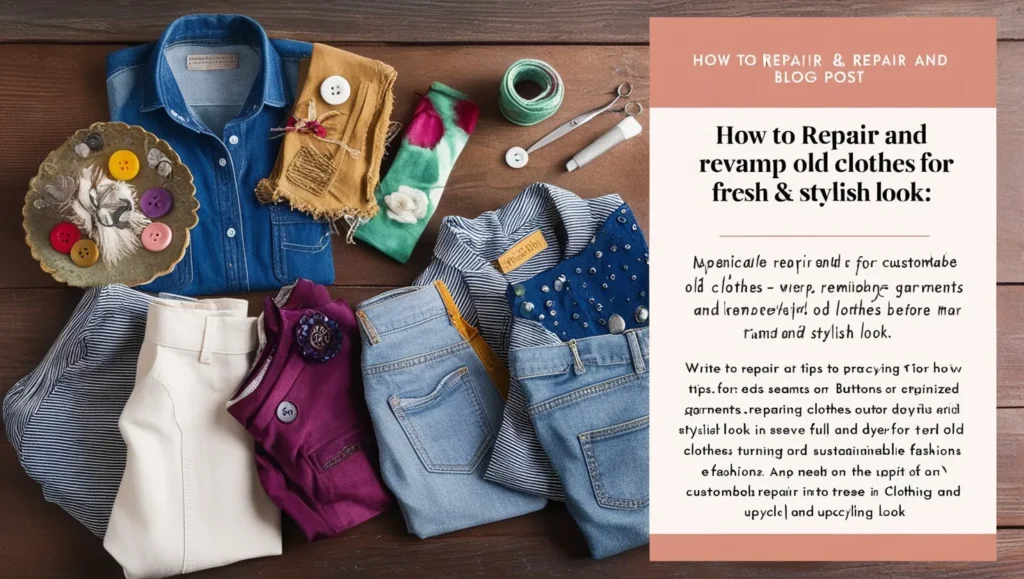How to Repair and Revamp Old Clothes for a New Look
Fashion trends come and go, but sustainability and creativity never go out of style. Instead of discarding worn-out or outdated clothes, why not breathe new life into them? Repairing and revamping old clothes not only saves money but also reduces waste, making it an eco-friendly choice. With a little creativity and basic sewing skills, you can transform your wardrobe into something fresh and unique. Here’s a detailed guide to help you repair and revamp old clothes for a whole new look.
Why Repair and Revamp Old Clothes?
- Cost Savings: Updating old garments is far cheaper than buying new ones.
- Eco-Friendly: Reducing textile waste helps the environment by cutting down on landfill contributions.
- Creative Expression: Personalizing clothes allows you to showcase your unique style.
- Sentimental Value: Repairing favorite pieces lets you continue wearing items you love.
Steps to Repair Old Clothes
- Identify the Problem
Inspect your clothing for common issues such as tears, loose seams, or missing buttons. Make a list of repairs needed. - Basic Mending Techniques
- Patch Small Holes: Use fabric patches or decorative appliqués to cover holes. Choose contrasting or matching colors for a creative twist.
- Fix Loose Seams: Reseam using a needle and thread or a sewing machine.
- Replace Missing Buttons: Use a similar or contrasting button for a stylish update.
- Repair Zippers: Replace broken zippers or clean and lubricate jammed ones with a graphite pencil.
- Strengthen Worn-Out Areas
Add reinforcements to areas like knees, elbows, or cuffs that endure wear and tear. Use durable fabrics for patches or interfacing.
Ways to Revamp Old Clothes
- Dye for a Fresh Look
Use fabric dyes to refresh faded clothes. Try tie-dye or ombré techniques for trendy designs. - Add Embellishments
- Beads and Sequins: Sew or glue embellishments onto plain tops or dresses for a glamorous touch.
- Iron-On Patches: Add quirky patches to jeans, jackets, or backpacks for a fun vibe.
- Customize with Paint
Use fabric paint or markers to create unique designs, patterns, or messages. Stencils can help with precision. - Alter for a Better Fit
Tailor oversized clothes to fit better. Crop long shirts or pants into trendy new pieces. - Combine Pieces
Merge two old garments into one. For example, turn a shirt and a skirt into a stylish dress. - Transform into Accessories
- Convert old T-shirts into headbands, scarves, or tote bags.
- Use denim scraps to create wallets or keychains.
Tips for Successful Repairs and Revamps
- Choose Quality Materials: Use durable threads, patches, and fabrics for long-lasting results.
- Practice Before You Begin: Test new techniques on scrap fabric.
- Invest in Tools: A good sewing kit, fabric scissors, and measuring tape are essential.
- Take Inspiration: Browse online platforms like Pinterest or Instagram for ideas.
- Patience Pays Off: Intricate projects may take time but are worth the effort.
Creative Revamp Ideas for Inspiration
- Distressed Jeans
Use sandpaper, scissors, or a razor to create trendy distressed jeans. Pair with a patch for a modern look. - Shirt to Halter Top
Cut and sew an old button-down shirt into a chic halter top. - Sweater to Cardigan
Slice an old pullover down the middle and hem the edges to make a stylish cardigan. - Dress to Skirt
Cut a worn-out dress above the waistline and add an elastic band to create a skirt. - Scarf-Decorated Handbag
Wrap an old scarf around a handbag’s handle for a fresh accessory.
The Bigger Picture: Sustainability in Fashion
Revamping old clothes aligns with the growing movement toward sustainable fashion. By reducing consumption and reusing what we already have, we contribute to a healthier planet. Every repaired or revamped garment is a step away from fast fashion’s negative impact on the environment.
Final Thoughts
Repairing and revamping old clothes is a rewarding blend of practicality and creativity. It allows you to extend the life of your garments, reduce waste, and express your personal style in unique ways. Whether you’re patching a hole, adding a splash of color, or transforming a piece entirely, the possibilities are endless. Start small, experiment, and watch your old wardrobe turn into a treasure trove of fresh fashion.
Would you like step-by-step guidance for any specific project? Let me know!

